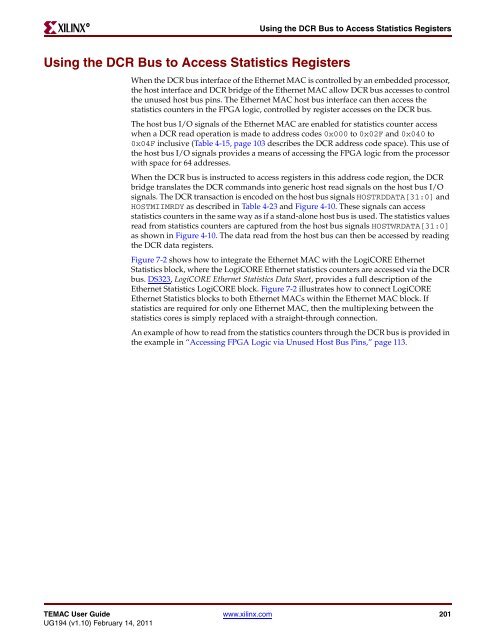Xilinx UG194 Virtex-5 FPGA Embedded Tri-Mode Ethernet MAC ...
Xilinx UG194 Virtex-5 FPGA Embedded Tri-Mode Ethernet MAC ...
Xilinx UG194 Virtex-5 FPGA Embedded Tri-Mode Ethernet MAC ...
You also want an ePaper? Increase the reach of your titles
YUMPU automatically turns print PDFs into web optimized ePapers that Google loves.
R<br />
Using the DCR Bus to Access Statistics Registers<br />
Using the DCR Bus to Access Statistics Registers<br />
When the DCR bus interface of the <strong>Ethernet</strong> <strong>MAC</strong> is controlled by an embedded processor,<br />
the host interface and DCR bridge of the <strong>Ethernet</strong> <strong>MAC</strong> allow DCR bus accesses to control<br />
the unused host bus pins. The <strong>Ethernet</strong> <strong>MAC</strong> host bus interface can then access the<br />
statistics counters in the <strong>FPGA</strong> logic, controlled by register accesses on the DCR bus.<br />
The host bus I/O signals of the <strong>Ethernet</strong> <strong>MAC</strong> are enabled for statistics counter access<br />
when a DCR read operation is made to address codes 0x000 to 0x02F and 0x040 to<br />
0x04F inclusive (Table 4-15, page 103 describes the DCR address code space). This use of<br />
the host bus I/O signals provides a means of accessing the <strong>FPGA</strong> logic from the processor<br />
with space for 64 addresses.<br />
When the DCR bus is instructed to access registers in this address code region, the DCR<br />
bridge translates the DCR commands into generic host read signals on the host bus I/O<br />
signals. The DCR transaction is encoded on the host bus signals HOSTRDDATA[31:0] and<br />
HOSTMIIMRDY as described in Table 4-23 and Figure 4-10. These signals can access<br />
statistics counters in the same way as if a stand-alone host bus is used. The statistics values<br />
read from statistics counters are captured from the host bus signals HOSTWRDATA[31:0]<br />
as shown in Figure 4-10. The data read from the host bus can then be accessed by reading<br />
the DCR data registers.<br />
Figure 7-2 shows how to integrate the <strong>Ethernet</strong> <strong>MAC</strong> with the LogiCORE <strong>Ethernet</strong><br />
Statistics block, where the LogiCORE <strong>Ethernet</strong> statistics counters are accessed via the DCR<br />
bus. DS323, LogiCORE <strong>Ethernet</strong> Statistics Data Sheet, provides a full description of the<br />
<strong>Ethernet</strong> Statistics LogiCORE block. Figure 7-2 illustrates how to connect LogiCORE<br />
<strong>Ethernet</strong> Statistics blocks to both <strong>Ethernet</strong> <strong>MAC</strong>s within the <strong>Ethernet</strong> <strong>MAC</strong> block. If<br />
statistics are required for only one <strong>Ethernet</strong> <strong>MAC</strong>, then the multiplexing between the<br />
statistics cores is simply replaced with a straight-through connection.<br />
An example of how to read from the statistics counters through the DCR bus is provided in<br />
the example in “Accessing <strong>FPGA</strong> Logic via Unused Host Bus Pins,” page 113.<br />
TE<strong>MAC</strong> User Guide www.xilinx.com 201<br />
<strong>UG194</strong> (v1.10) February 14, 2011

















